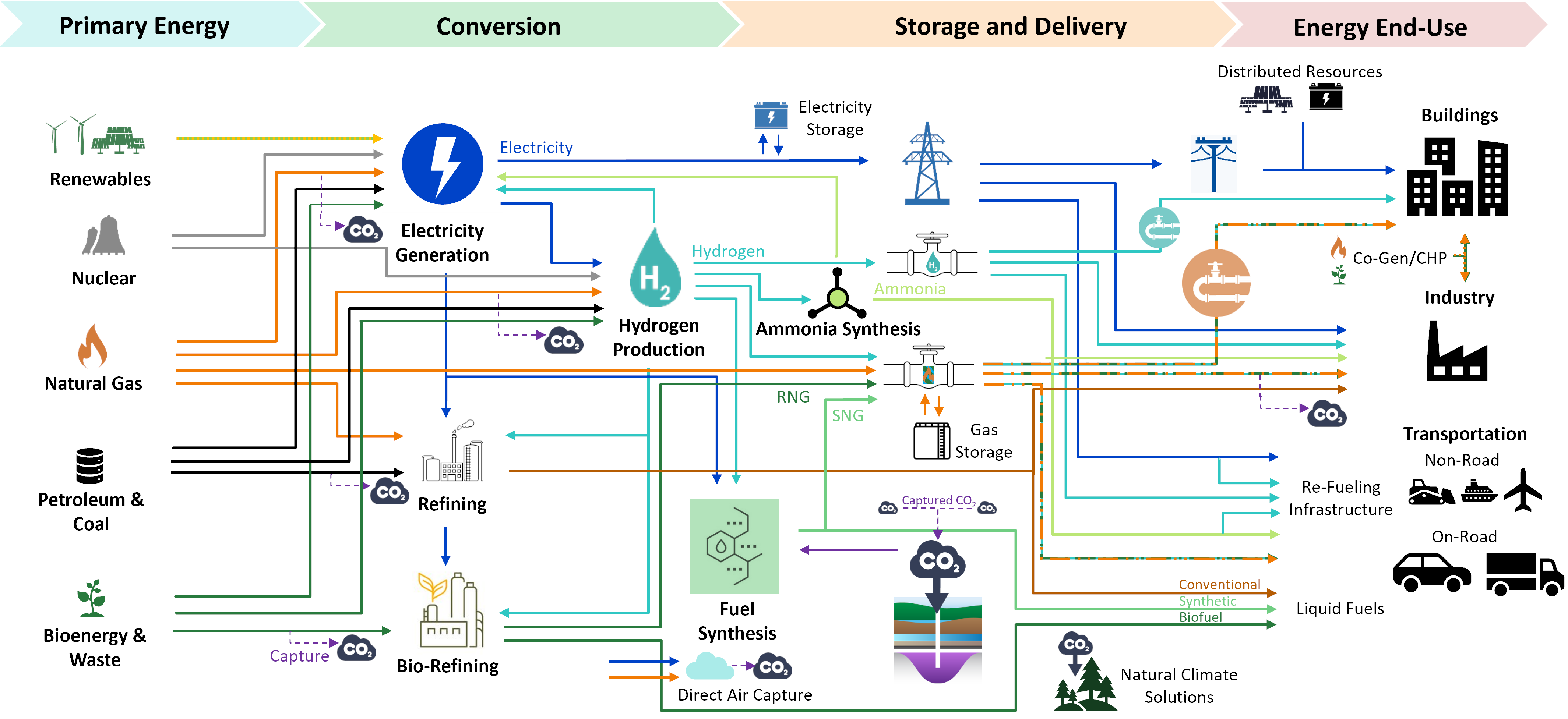Modeling Approach

The analysis was conducted using EPRI’s US-REGEN modeling platform (Figure 2), an energy-economy system model with a detailed representation of electric sector capacity and dispatch, end-use sector activities and technologies, and non-electric fuel supply, including natural gas, petroleum, and an expanded set of fuel pathways including bioenergy conversion, hydrogen, ammonia, and other hydrogen-derived fuels. These pathways are represented using explicit technology representations for each step in converting, storing, and delivering primary energy to end-use customers. Figure 1 shows the scope of technologies and pathways modeled in US-REGEN. While not all of these pathways may be used or needed in a given scenario, the model’s optimization approach considers each option in deriving a least-cost configuration of resources to meet both energy service demands and the net-zero emissions target.
A forward-looking scenario exercise using a complex model requires many assumptions about parameters whose future values are uncertain. The methodology for developing reliable and consistent technology cost and performance estimates is based on EPRI’s well-established Technology Assessment Guide (TAG) framework. The TAG process relies on detailed, engineering-based studies with clearly defined cost boundaries (total capital required, operating, and maintenance) and design assumptions. Technology cost and performance assessments leverage EPRI’s and GTI Energy’s internal technical knowledge, industry experience, and collaboration with engineering, procurement, and construction (EPC) firms. The LCRI has applied this process to evaluate traditional supply-side power generation, renewable energy, energy storage, low-carbon, and zero-carbon energy technologies. Estimates are developed based on a current state reflective of near-term market assessments, as well as estimated future costs as a function of technology learning potential. A detailed overview of the US-REGEN formulation and assumptions for technology cost and performance, as well as other key parameters, is provided on the US-REGEN online documentation website, us-regen-docs.epri.com.
This study is part of emerging literature that has investigated net-zero emissions energy systems in the U.S. and other countries (Bistline, 2021).[1] Several net-zero studies for the U.S. assume end-use decisions by households and businesses as model inputs (Larson et al., 2020; Williams et al., 2021). In this analysis, energy supply and demand decisions are model outputs that respond to scenario-specific differences in technology and policy drivers. Other net-zero studies use models with lower technological, temporal, and spatial detail (DeAngelo et al., 2021). This study uses EPRI’s US-REGEN model with hourly resolution for electricity load shapes and investment decisions, a new fuels model that represents a range of low-carbon conversion pathways, and end-use representations with detailed structural classes to characterize the economics of adoption and utilization more accurately. This analysis is also unique in its independent, detailed, and consistent assessment of the cost and performance of different supply and demand side technologies.
Bistline (2021). Roadmaps to Net-Zero Emissions Systems: Emerging Insights and Modeling Challenges. Joule, 5(10): 2551-2563.
DeAngelo, et al. (2021). Energy Systems in Scenarios at Net-Zero CO2 Emissions. Nature Communications, 12: 6096.
Larson, et al. (2020). Princeton University Net-Zero America: Potential Pathways, Infrastructure, and Impacts. Princeton University.
Williams, et al. (2021). Carbon-Neutral Pathways for the United States. AGU Advances 2. ↩︎